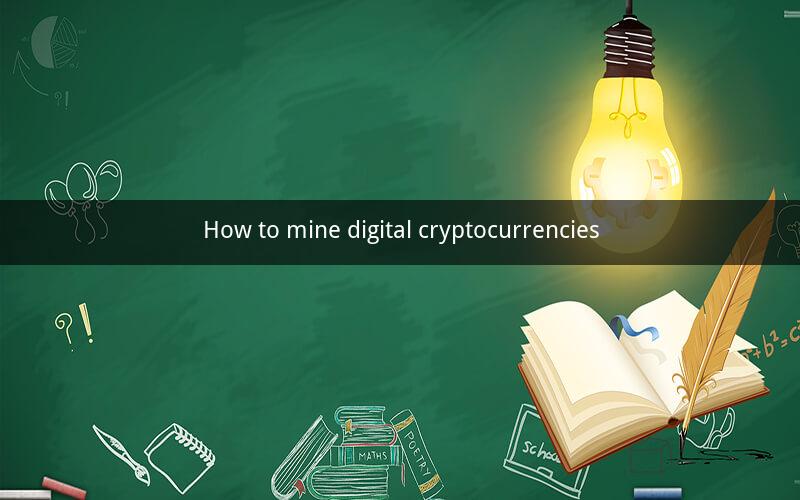
How to Mine Digital Cryptocurrencies: A Comprehensive Guide
Table of Contents
1. Introduction to Cryptocurrency Mining
2. Understanding the Basics of Blockchain Technology
3. The Importance of Hardware and Software
4. Choosing the Right Cryptocurrency to Mine
5. Setting Up Your Mining Rig
6. Optimizing Your Mining Rig for Efficiency
7. Joining a Mining Pool
8. Staying Secure and Compliant
9. The Economic and Environmental Implications of Mining
10. Future Trends in Cryptocurrency Mining
1. Introduction to Cryptocurrency Mining
Cryptocurrency mining is the process by which new units of cryptocurrency are entered into circulation. It is also a critical component of the maintenance and development of the blockchain ledger. Miners use computers to solve complex mathematical problems, and when they find the solution, they are rewarded with cryptocurrency.
2. Understanding the Basics of Blockchain Technology
Blockchain technology is the backbone of cryptocurrency. It is a decentralized ledger that records transactions across many computers so that the record cannot be altered retroactively without the alteration of all subsequent blocks and the consensus of the network. This ensures the integrity and security of the system.
3. The Importance of Hardware and Software
The hardware and software you choose will significantly impact your mining efficiency and profitability. High-performance GPUs or ASICs are essential for mining, as they can solve complex algorithms at a faster rate. Additionally, reliable mining software is crucial for monitoring and managing your mining operations.
4. Choosing the Right Cryptocurrency to Mine
Not all cryptocurrencies are equally profitable to mine. Factors such as the difficulty of mining, the current price of the cryptocurrency, and the reward structure should be considered. Bitcoin, for example, is the most popular cryptocurrency but also the most difficult to mine.
5. Setting Up Your Mining Rig
To start mining, you'll need to set up a mining rig. This involves selecting the right hardware, assembling it, and installing the necessary software. It's important to ensure that your rig is well-ventilated to prevent overheating.
6. Optimizing Your Mining Rig for Efficiency
Efficiency is key in cryptocurrency mining. You can optimize your rig by adjusting the fan speeds, using efficient power supplies, and keeping the rig cool. Additionally, monitoring your rig's performance and making adjustments as needed can improve efficiency.
7. Joining a Mining Pool
Mining solo can be challenging, especially for beginners. Joining a mining pool allows you to combine your computing power with others, increasing your chances of earning rewards. It's important to choose a reputable mining pool that offers fair rewards and low fees.
8. Staying Secure and Compliant
Security is paramount in cryptocurrency mining. Ensure that your rig is protected from malware and that your cryptocurrency is stored in a secure wallet. Additionally, be aware of the legal and regulatory aspects of mining in your jurisdiction.
9. The Economic and Environmental Implications of Mining
Mining cryptocurrencies requires significant computational power, which consumes a lot of electricity. This has raised concerns about the environmental impact of mining. It's important to consider the sustainability of your mining operations.
10. Future Trends in Cryptocurrency Mining
The future of cryptocurrency mining is uncertain, but several trends are emerging. The rise of quantum computing could potentially render current mining algorithms obsolete. Additionally, advancements in blockchain technology may lead to more efficient and sustainable mining practices.
---
10 Questions and Answers
Q1: What is the difference between a GPU and an ASIC in cryptocurrency mining?
A1: GPUs (Graphics Processing Units) are versatile and can be used for a variety of tasks, including gaming and mining. ASICs (Application-Specific Integrated Circuits) are designed specifically for mining and are more efficient than GPUs for this purpose.
Q2: How do I choose the right mining pool?
A2: Look for a mining pool with a good reputation, low fees, and a user-friendly interface. Consider the pool's location, as this can affect your mining efficiency due to differences in electricity costs.
Q3: What is the best cryptocurrency to mine in 2023?
A3: The best cryptocurrency to mine depends on factors such as difficulty, price, and reward structure. Research current trends and consult mining profitability calculators to make an informed decision.
Q4: How can I prevent my mining rig from overheating?
A4: Ensure your rig has adequate ventilation, use efficient cooling systems, and avoid placing it in a warm environment. Regularly check the temperature and adjust the fan speeds if necessary.
Q5: What are the legal implications of mining cryptocurrencies in my country?
A5: Check the laws and regulations in your country regarding cryptocurrency mining. Some countries may have restrictions or require licenses for mining operations.
Q6: How do I calculate the profitability of my mining rig?
A6: Use mining profitability calculators available online. These tools take into account the hardware specifications, electricity costs, and the current price of the cryptocurrency to estimate your potential earnings.
Q7: Can I mine cryptocurrencies with a regular computer?
A7: While it's possible to mine with a regular computer, it's not efficient. A dedicated mining rig with high-performance hardware is recommended for serious mining operations.
Q8: What is the role of a mining pool in cryptocurrency mining?
A8: A mining pool is a group of miners who work together to increase their chances of earning rewards. When a block is successfully mined by the pool, the rewards are distributed among the participants according to their contribution.
Q9: How can I stay secure while mining cryptocurrencies?
A9: Use strong passwords, keep your software updated, and be cautious of phishing scams. Store your cryptocurrency in a secure wallet and avoid keeping large amounts on exchanges.
Q10: What are the potential environmental impacts of cryptocurrency mining?
A10: Cryptocurrency mining consumes a lot of electricity, which can lead to increased carbon emissions. It's important to consider the sustainability of your mining operations and support efforts to reduce the environmental impact of mining.